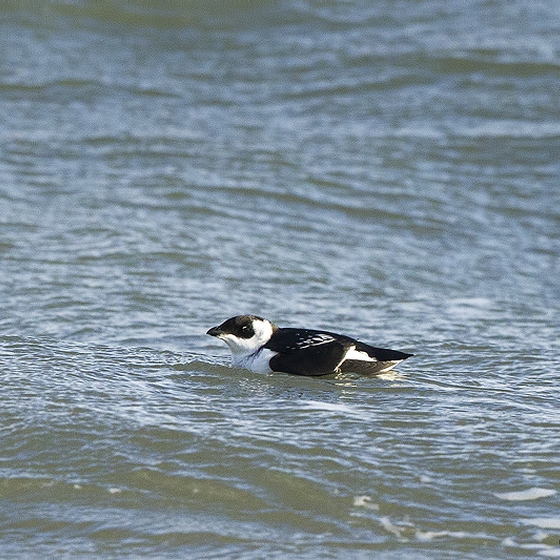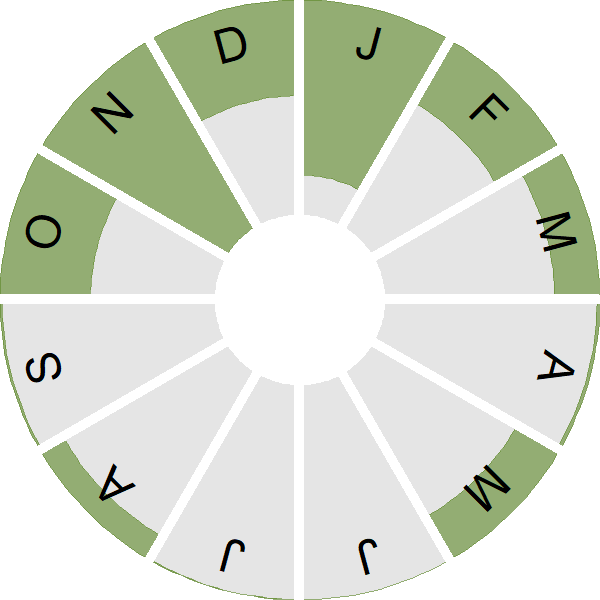Little Auk

Introduction
This diminutive auk, not much larger than a Starling, is a winter visitor to our coastal waters in varying numbers.
The Norwegian archipelago of Svalbard holds around 90% of the world's breeding Little Auks. Estimates for the world breeding population are difficult to assess but the European estimate of around 80 million individuals gives some insight into the numbers involved.
After the breeding season Little Auks head south to their wintering areas. The northern part of the North Sea is an important wintering location for Little Auks and the birds remain at sea throughout the winter months, only being seen close to shore when driven there by winter storms. Occasional reports of individuals found far inland are associated with particularly rough storms.

Key Stats
Identification
ID Videos
This section features BTO training videos headlining this species, or featuring it as a potential confusion species.
Winter Auks
Status and Trends
Conservation Status
Population Size
Population Change
Little Auk is a scarce, but regular, autumn passage and winter visitor to the UK, seen mostly along the North Sea coast and south coast of England [Balmer et al. 2013]. The UK is at the southern end of the species' European winter range [del Hoyo et al. 1996]. The European population trend is unknown [BirdLife International 2018].
Distribution
Little Auks are scarce but regular autumn passage migrants and winter visitors, often driven south after strong northerly gales. Most records were from North Sea coastal squares from Shetland south to Kent, though they also occurred along the south coast of England. Little Auks are relatively scarce in west-coast and Irish waters.
Occupied 10-km squares in UK
or view it on Bird Atlas Mapstore.
or view it on Bird Atlas Mapstore.
European Distribution Map
Distribution Change
Change in occupied 10-km squares in the UK
or view it on Bird Atlas Mapstore.
Seasonality
Little Auks are late autumn passage migrants and winter visitors, often associated with winter storms.
Weekly pattern of occurrence
The graph shows when the species is present in the UK, with taller bars indicating a higher likelihood of encountering the species in appropriate regions and habitats.

Movement
Britain & Ireland movement
Foreign locations of birds ringed or recovered in Britain & Ireland
Dots show the foreign destinations of birds ringed in Britain & Ireland, and the origins of birds ringed overseas that were subsequently recaptured, resighted or found dead in Britain & Ireland. Dot colours indicate the time of year that the species was present at the location.
- Winter (Nov-Feb)
- Spring (Mar-Apr)
- Summer (May-Jul)
- Autumn (Aug-Oct)

European movements
EuroBirdPortal uses birdwatcher's records, such as those logged in BirdTrack to map the flows of birds as they arrive and depart Europe. See maps for this species here.
The Eurasian-African Migration Atlas shows movements of individual birds ringed or recovered in Europe. See maps for this species here.
Biology
Productivity and Nesting
Nesting timing
Egg measurements
Clutch Size
Survival and Longevity
Survival is shown as the proportion of birds surviving from one year to the next and is derived from bird ringing data. It can also be used to estimate how long birds typically live.
View number ringed each year in the Online Ringing Report.
Biometrics
Wing length and body weights are from live birds (source).
Ring Size
Classification, names and codes
Classification and Codes
- Order: Charadriiformes
- Family: Alcidae
- Scientific name: Alle alle
- Authority: Linnaeus, 1758
- BTO 2-letter code: LK
- BTO 5-letter code: LITAU
- Euring code number: 6470
Alternate species names
- Catalan: gavotí atlàntic
- Czech: alkoun malý
- Danish: Søkonge
- Dutch: Kleine Alk
- Estonian: väikealk e. ürr
- Finnish: pikkuruokki
- French: Mergule nain
- Gaelic: Colcach-bheag
- German: Krabbentaucher
- Hungarian: alkabukó
- Icelandic: Haftyrðill
- Irish: Falcóg Bheag
- Italian: Gazza marina minore
- Latvian: mazais alks
- Lithuanian: mažoji alka
- Norwegian: Alkekonge
- Polish: alczyk
- Portuguese: torda-miúda
- Slovak: alkovec drobný
- Slovenian: rakovicar
- Spanish: Mérgulo atlántico
- Swedish: alkekung
- Welsh: Carfil Bach
- English folkname(s): Dovekie
Research
Causes of Change and Solutions
Causes of change
As the population trend is unknown, there are no causes of change to note.

